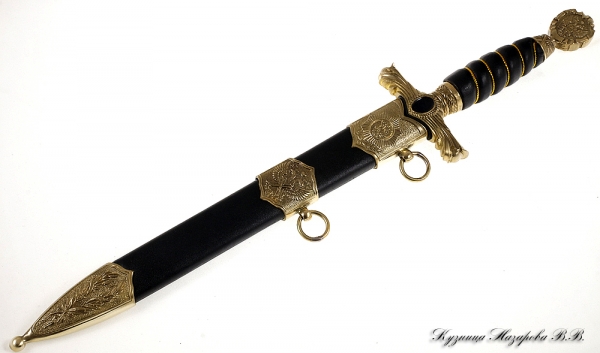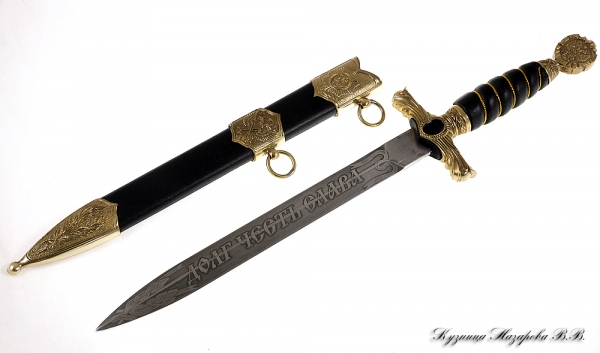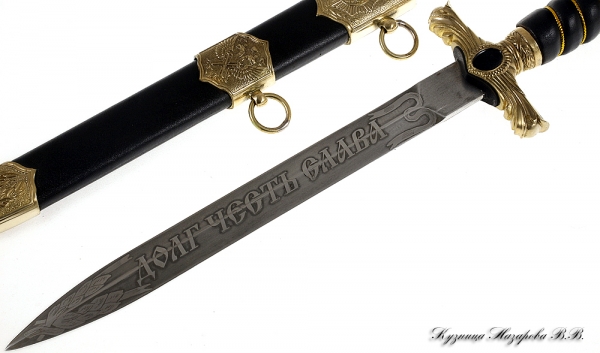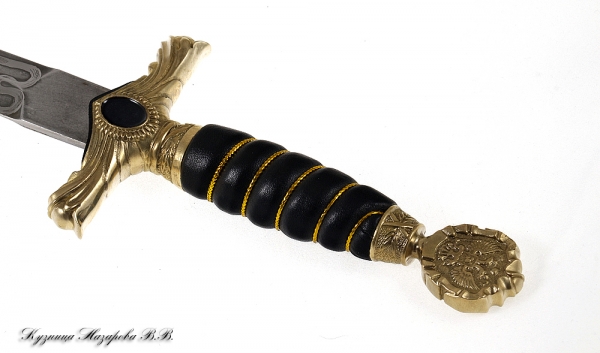- Главная
- Ножи ручной работы
- По типам ножа
- Кортики сувенирные
- Генеральские кортики
- Генеральские кортики
- The General 's cutlass of Andrew the First - Called
The General 's cutlass of Andrew the First - Called
The General 's cutlass of Andrew the First - Called
- Форма клинкаКортик
- Blade steel tipe65x13
- Lengtn blade (os)221 mm
- Witdth blade (os)20 mm
- Толщина клинка3.5 mm
- Lengtn handle (os) 95 mm
- Hardness (HRC)25
- SheathPlastic, brass
- Product weight, gram400
Analysis of properties and features
Blade steel — 65x13: This Russian corrosion-resistant steel is widely used for cutting tools due to its high resistance to moisture. However, in this instance, the hardness of the blade is 25 HRC, which is significantly lower than the standard values for knives and cutlasses (usually 54-58 HRC for 65x13). This means that the blade will be flexible enough, but it loses in wear resistance: it quickly loses its cutting edge and does not keep sharpening well. At the same time, its low hardness makes it less brittle and safer for ceremonial or souvenir use.
The shape of the blade is a dirk:The classic dirk is a straight, double—edged blade with a symmetrical geometry, historically designed for piercing and light cuts. This uniform is ideal for ceremonial functions, collection purposes, or as a uniform element, as it emphasizes the status of the wearer and carries deep symbolism.
Dimensions:The blade length of 221 mm and width of 20 mm create a graceful and elegant silhouette typical of general's and ceremonial cutlasses. The 3.5 mm thickness of the blade gives the product some strength, but against the background of low hardness, this advantage is negated.
Handle material:There are no data available, but the materials typical for cutlasses (wood, plastic, metal, or combinations thereof) ensure gripping and reliable retention during ceremonial actions, and are not designed for heavy or extreme use.
The scabbard: The combination of plastic and brass emphasizes the status, protects the blade from moisture, preserving its appearance for many years.
Scope of application: advantages and limitations
- Optimal application: This dirk is intended for ceremonial, collectible purposes, awards, as well as as a symbol of status or historical significance. It is ideal for celebrations, collectors of historical weapons, as well as as a valuable gift.
- Holding in the hand: The ergonomics of the handle is designed for ceremonial wear and presentation, ensures secure retention in ceremonial conditions, and is not intended for long-term work or military operations.
- Resistance to moisture and corrosion: 65x13 steel has excellent corrosion resistance, which is especially important for products that are often in contact with a humid environment or require maintaining an impeccable appearance.
- Wear resistance and durability: Due to its low hardness (25 HRC), the blade quickly blunts and cannot withstand heavy loads, and is not suitable for household, field or combat tasks.
- Easy maintenance:The low hardness makes it easy to sharpen the blade, but it also requires regular sharpening during active use. For ceremonial use, maintenance is practically not required.
- Limitations: It is absolutely not suitable for cutting, chopping or use in household and outdoor tasks; it cannot withstand prolonged or heavy loads. The double-edged shape requires careful handling.
Unique properties and historical emphasis
The dirk is not just a knife, but a symbol of military valor, power and traditions, which is especially important for general models associated with the history of the Order of St. Andrew the First-Called. The elegance of the shapes and attention to detail emphasize the product's status as an element of a ceremonial uniform and a valuable piece of a collection of weapons. High-quality handwork ensures the uniqueness of each piece.
Care recommendations
Thanks to the stainless steel and the scabbard with brass elements, the dirk is quite easy to care for: it is enough to periodically wipe the blade with a soft, dry cloth and store it in a dry place. If it is used as a collector's item or a ceremonial item, no regular sharpening is required. It is not recommended to expose the product to shocks and loads.
Final recommendation
The dirk is recommended for collectors, officers, historians and those who are looking for a status and aesthetically perfect attribute to complete the dress uniform, as well as for connoisseurs of handmade. The product is not suitable for practical use, active tourism, hunting or household work. Its value lies in its solemnity, symbolism and collectible uniqueness.
Help other users with the choice - be the first to share your opinion about this product.










